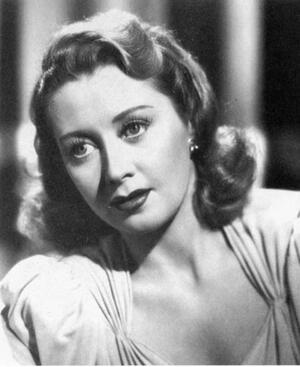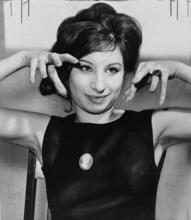Joan Blondell
Known for playing character roles as a wisecracking, working-class girl, Joan Blondell performed in movies, television, and on stage from age one until her death. After winning a “Miss Dallas” contest, Blondell moved to New York, where her performance in the 1929 Broadway musical Penny Arcade caught the attention of Warner Brothers, who signed her in 1930. Blondell was frustrated by the parts the studio assigned her, preferring light comedies. She left Warner Brothers in 1938, freelancing for Fox, MGM, and television shows. She became known as a solid character actress and earned an Academy Award nomination for her performance in The Blue Veil in 1951. In 1972 she wrote a novel, Center Door Fancy, heavily based on her own life and career.
Article
A beautiful and accomplished stage and screen actress, Blondell was born on August 30, 1906 (some accounts say 1909), on Manhattan’s Upper West Side. The daughter of vaudeville comics Eddie and Kathryn Blondell, she got whatever schooling she could in whatever city her parents happened to be performing. She made her debut in the family show at age one. Blondell toured all over the United States, Europe, Australia, and China with the troupe, then settled in Dallas, Texas, where she joined a stock company in 1926. Her sister Gloria was also an actress.
Blondell came to New York City after she won a “Miss Dallas” beauty contest in Texas. Her performance in the 1929 Broadway musical Penny Arcade, which also featured James Cagney, caught the attention of Warner Brothers, who signed both of them in 1930. The studio adapted the play for the screen, renaming it Sinners’ Holiday.
Throughout the 1930s, Blondell remained in Hollywood, working for Warner Brothers, often playing second lead, in the role of the wisecracking but good-natured working-class gal. At Warner, she gained recognition as the indefatigable gold digger in films such as Blonde Crazy and Footlight Parade. Though she worked hard, like most actresses in that era, she felt the studio underutilized her talent—particularly her affinity for light comedy. While audiences appreciated the assured optimism her characters possessed on-screen, it was her self-deprecating humor that sustained her offscreen.
Blondell left Warners in 1938 and began to freelance, acting smaller parts in a number of Fox and MGM films and, later, television. She mainly played character roles, such as Aunt Cissy in the 1945 production of A Tree Grows in Brooklyn with director Elia Kazan. In 1951, Blondell received an Academy Award nomination for her performance in The Blue Veil. She appeared in three television series in the 1960s and 1970s: The Real McCoys, Here Come the Brides, and Banyon. In 1972 she wrote the novel Center Door Fancy, a work of thinly disguised fiction based on her own career.
Blondell was married to cinematographer George Barnes from 1933 to 1935, to actor Dick Powell from 1936 to 1945, and to producer Mike Todd from 1947 to 1950. She had one son, Norman, with Barnes, and a daughter, Ellen, with Powell. She died in Santa Monica, California, on December 25, 1979, of leukemia.
Filmography
Adventure (1946).
The Amazing Mr. Williams (1939).
Angel Baby (1961).
Back in Circulation (1937).
Big Business Girl (1931).
Big City Blues (1932).
Big Daddy (1969).
Blonde Crazy (1931).
Blondie Johnson (1933).
The Blue Veil (1951).
Broadway Bad (1933).
Broadway Gondolier (1935).
Bullets or Ballots (1936).
Central Park (1932).
The Champ (1979).
Christmas Eve (1947).
The Cincinnati Kid (1965).
Colleen (1936).
Convention City (1933).
The Corpse Came C.O.D. (1947).
The Crowd Roars (1932).
Cry Havoc (1943).
Dames (1934).
The Desk Set (1958).
Don Juan Quilligan (1945).
East Side of Heaven (1939).
Famous Ferguson Case (1932).
Footlight Parade (1933).
For Heaven’s Sake (1950).
The Glove (1978).
God’s Gift to Women (1931).
Gold Diggers of 1933 (1933).
Gold Diggers of 1937 (1936).
Good Girls Go to Paris (1939).
Goodbye Again (1933).
Grease (1978).
The Greeks Had a Word for Them (1932).
Havana Windows (1933).
He Was Her Man (1934).
I Want a Divorce (1940).
Illicit (1931).
I’ve Got Your Number (1934).
The Kansas City Princess (1934).
The Kid from Kokomo (1939).
The King and the Chorus Girl (1937).
Kona Coast (1968).
Lady for a Night (1942).
Lawyer Man (1933).
Lizzie (1957).
Make Me a Star (1932).
Millie (1931).
Miss Pacific Fleet (1935).
Miss Pinkerton (1932).
Model Wife (1941).
My Past (1931).
Night Nurse (1931).
Nightmare Alley (1947)
Off the Record (1939).
The Office Wife (1930).
Opening Night (1977).
The Opposite Sex (1956).
Other Men’s Women (1930, 1931).
The Perfect Specimen (1937).
The Public Enemy (1931).
The Reckless Hour (1931).
Ride Beyond Vengeance (1966).
Sinners’ Holiday (1930).
Smarty (1934).
Sons o’ Guns (1936).
Stage Struck (1936).
Stand-In (1937).
Stay Away from Joe (1968).
Support Your Local Gunfighter (1971).
There’s Always a Woman (1938).
This Could Be the Night (1957).
Three Girls About Town (1941).
Three Men on a Horse (1936).
Three on a Match (1932).
Topper Returns (1941).
The Traveling Saleslady (1935).
A Tree Grows in Brooklyn (1945).
Two Girls on Broadway (1940).
Union Depot (1932).
Waterhole 3 (1967).
We’re in the Money (1935).
Will Success Spoil Rock Hunter? (1958).
The Woman Inside (1980).
Blondell, Joan. Center Door Fancy (1972), and Clippings file. New York Public Library for the Performing Arts. New York.
Bowers, Ron. “Joan Blondell.” Films in Review 23, no. 4 (April 1972).
Katz, Ephraim. The Film Encyclopedia (1979).
Mordden, Ethan. Movie Star: A Look at the Women Who Made Hollywood (1983).
Picturegoer and Film Weekly (December 23, 1939): 10–11.
Quinlan, David. Quinlan’s Illustrated Registry of Film Stars (1981).
Rigdon, Walter, ed. Who’s Who of the American Theatre (1966).
Thomas, Nicholas, ed. International Dictionary of Films and Filmmakers. Vol. 3, Actors and Actresses (1992).
Thomson, David. A Biographical Dictionary of Film. 3d ed. (1994).
UJE.




